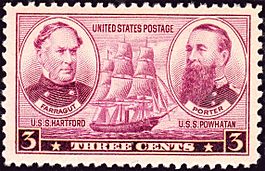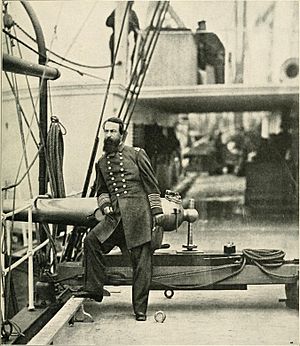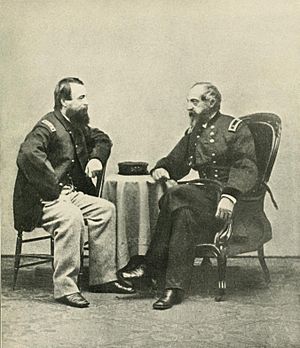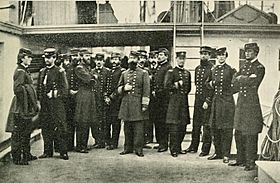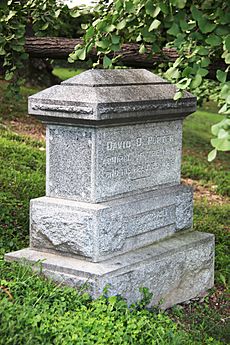David Dixon Porter facts for kids
Quick facts for kids
David Dixon Porter
|
|
|---|---|
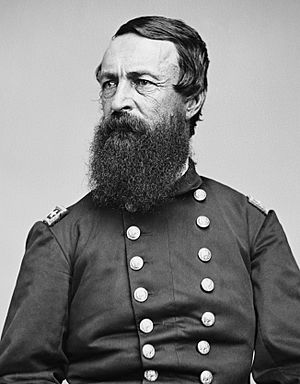
Porter in the 1860s, during the American Civil War
|
|
| Born | June 8, 1813 Chester, Pennsylvania, U.S. |
| Died | February 13, 1891 (aged 77) Washington, D.C., U.S. |
| Buried | |
| Allegiance | |
| Service/ |
|
| Years of service | 1825–1828 (Mexico) 1829–1891 (US) |
| Rank | Midshipman (Mexico) |
| Commands held | Superintendent of the U.S. Naval Academy Board of Inspection |
| Battles/wars | |
| Relations | David Porter (father) |
| Other work | Incidents and Anecdotes of the Civil War (1885) |
| Signature | |
David Dixon Porter (born June 8, 1813 – died February 13, 1891) was a very important United States Navy admiral. He came from a famous family of naval officers. Porter was the second person in the U.S. Navy to become an admiral, right after his adoptive brother David G. Farragut. He helped make the Navy better as the leader of the U.S. Naval Academy. This was after he served bravely in the American Civil War.
Porter started his naval career at just 10 years old. He was a midshipman, a junior officer in training, serving with his father, Commodore David Porter. He fought in the Mexican–American War and later played a big role in the Civil War. He led a group of special mortar boats to capture New Orleans. He also commanded the Navy's ships on the Mississippi River during the important Vicksburg Campaign. After the war, he worked hard to improve training at the Naval Academy.
Contents
Who Was David Dixon Porter's Family?
David Dixon Porter was born in Chester, Pennsylvania, on June 8, 1813. His parents were David Porter and Evalina Porter. His family had a long history of serving in the Navy. His grandfather and uncle were captains in the American Revolutionary War. His father, David Porter, was a famous commodore in the War of 1812.
David Dixon was one of 10 children. Five of his brothers also became officers. Four of them joined the U.S. Navy. His brother Theodoric became an officer in the U.S. Army.
His parents also adopted James Glasgow Farragut. James's father was a friend of David Porter Sr. James later changed his name to David. He became the first person to reach the rank of admiral in the U.S. Navy. This happened after the American Civil War.
David Dixon Porter's father, Commodore David Porter, left the U.S. Navy in 1824. He then became the commander of the Mexican Navy. He took his sons, David Dixon and Thomas, with him. Both boys became midshipmen. Sadly, Thomas died from yellow fever at age 10.
David Dixon, who was 12, did not get sick. He served on a ship called Libertad. He also went on a raid against Spanish ships in Cuban waters. In 1828, David Dixon joined his cousin, David Henry Porter, on the ship Guerrero. They fought a Spanish fleet. His cousin was killed in the battle, and young David Dixon was slightly hurt. He was captured and held in Havana. His father then sent him back to the United States.
David Dixon Porter officially joined the U.S. Navy as a midshipman on February 2, 1829. He was 16 years old. He was older and had more experience than many other midshipmen. This sometimes made him a bit too confident with his superiors.
He served on the ship USS United States. During this time, he met George Ann Patterson, who he later married. After passing his exams, he worked for the Coast Survey. This job paid well enough for him to save money for his wedding.
David Dixon Porter's Family Life
Porter married George Ann Patterson on March 10, 1839. They had four sons and two daughters who lived to adulthood. Many of their children and grandchildren also served in the military.
- Major David Essex Porter served in the army during the Civil War.
- Captain Theodoric Porter made his career in the navy.
- Lieutenant Colonel Carlile Patterson Porter was an officer in the U.S. Marine Corps. His son, David Dixon Porter II, also became a major general in the Marines and earned the Medal of Honor.
- Their daughter Elizabeth married Leavitt Curtis Logan, who became a Rear Admiral.
Becoming an Officer
In March 1841, Porter was promoted to lieutenant. He then worked at the U.S. Navy's Hydrographic Office. In 1846, he went on a secret mission to Santo Domingo (now the Dominican Republic). He gathered information for the U.S. government. While he was away, the United States went to war with Mexico.
Leading Ships in War
Mexican-American War Service
During the Mexican–American War, Porter was the first lieutenant on the gunboat USS Spitfire. He was at Vera Cruz when U.S. forces attacked the city. Porter knew the area well from his time in the Mexican Navy. He helped guide ships into the harbor to attack the forts.
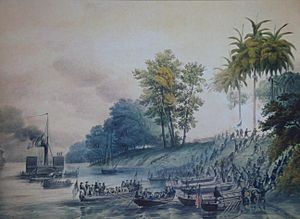
In June 1847, Porter led 68 sailors to capture a fort in Tabasco. For his bravery, he was made captain of the Spitfire. This was his first time commanding his own ship.
Civilian Work Before the Civil War
After the Mexican War, Porter took a break from the Navy. He commanded civilian steamships to gain experience with them. He even brought camels to the United States for the Army to use in the desert! In 1859, he was offered a job as a ship captain for a private company, but the American Civil War began before he could take it.
Civil War Contributions
Helping Fort Pickens
When the Civil War started, some Southern states tried to take over U.S. forts. President Abraham Lincoln wanted to keep Fort Pickens in Florida. Porter helped create a secret plan to send supplies and soldiers to the fort. This plan involved the steam frigate USS Powhatan. This mission was kept secret even from the Secretary of the Navy, Gideon Welles.
Because Powhatan was sent to Fort Pickens, it couldn't help at Fort Sumter in South Carolina. Fort Sumter fell to the Confederates, starting the Civil War. Even though this caused problems, Lincoln forgave Porter. Porter's loyalty to the Union was now clear.
Mortar Fleet at New Orleans and Vicksburg
In late 1861, the Navy planned to take control of the Mississippi River. The first step was to capture New Orleans. Porter, now a commander, was put in charge of a group of about twenty mortar boats. These boats fired large shells at enemy forts. His adoptive brother, David G. Farragut, commanded the main fleet.
The attack on Fort Jackson and Fort St. Philip began on April 18, 1862. Porter's mortars fired for five days. Farragut then decided to sail his fleet past the forts. Porter's mortars kept firing to distract the enemy. Farragut's fleet got past the forts and captured New Orleans. The forts surrendered to Porter on April 28.
Farragut then moved his fleet upriver to Vicksburg, Mississippi. The forts there were too high for his ships' guns. Porter brought his mortar fleet to Vicksburg. The mortars helped Farragut's ships get past the enemy batteries. However, Vicksburg could not be taken without the Army's help. Porter was later ordered to leave Vicksburg to help in another campaign.
Becoming a Rear Admiral
In the summer of 1862, the U.S. Navy changed its ranks to match the Army's. New ranks like commodore and rear admiral were created. The Navy wanted to replace the commander of the Mississippi River Squadron. Secretary Welles chose Porter for the job, even though he was only a commander.
So, Commander Porter became Acting Rear Admiral Porter. He skipped the ranks of captain and commodore. He took command of the Mississippi Squadron on October 15, 1862. He quickly became friends with Major General William T. Sherman. He also worked well with Major General Ulysses S. Grant.
Close teamwork between the Army and Navy was key to winning the Vicksburg Campaign. Porter's fleet helped Grant's army by sailing past the Vicksburg batteries at night. Only one ship was lost. This allowed Grant to move his troops south of Vicksburg. The Navy also kept a blockade around Vicksburg. When Vicksburg fell on July 4, 1863, Grant praised Porter's help. For this victory, Porter's rank of "acting" rear admiral became permanent.
The Red River Expedition
After Vicksburg, Admiral Porter was ordered to work with General Nathaniel P. Banks on a campaign along the Red River in Louisiana. Porter thought it was a bad idea, but he followed orders. The river was difficult to navigate, and the Army and Navy did not work well together. The main goal of the campaign seemed to be seizing cotton.
Confederate forces defeated Banks's army. Porter's main task then became getting his fleet out of the river. The water levels were falling, making it very hard. But with the help of soldiers, he managed to save most of his ships.
Capturing Fort Fisher
By late 1864, Wilmington, North Carolina, was the last major port open for Confederate ships. The Navy planned to close it by capturing Fort Fisher. Porter was put in charge of the naval attack.
The attack needed the Army's help. General Benjamin F. Butler led the Army troops. Butler suggested blowing up a ship filled with gunpowder near the fort. Porter agreed. On December 24, 1864, the ship USS Louisiana exploded, but it had no effect on the fort. Butler then pulled his troops back without a full attack.
Porter was very angry. He convinced General Grant to remove Butler. General Alfred H. Terry took over. The second attack began on January 13, 1865. Porter's ships fired at specific targets on the fort, aiming to destroy the enemy's guns. They kept firing even as the troops attacked. On January 15, Terry's soldiers and 2000 sailors and marines attacked the fort from different sides. They captured Fort Fisher. This was the last big naval battle of the war.
Touring Richmond with President Lincoln
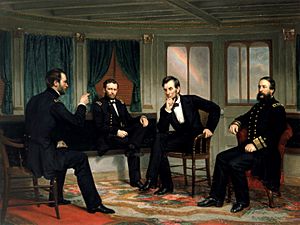
In April 1865, the Civil War was almost over. The Confederate capital of Richmond was captured. Porter walked through the city with U.S. President Abraham Lincoln and bodyguards. He later wrote about how many freed slaves rushed to see Lincoln.
Lincoln's Assassination
A few weeks after their visit to Richmond, President Lincoln was assassinated. Porter was very sad. He admired Lincoln greatly and felt some responsibility, wishing he could have been there to prevent it.
After the War
After the war, the U.S. Navy became much smaller. In 1865, Secretary Welles made Porter the Superintendent of the Naval Academy. The Academy needed many changes.
Porter wanted to make the Naval Academy as good as the Military Academy at West Point. He changed the courses to better prepare officers for naval life. He encouraged sports and made sure discipline was strong. He also started an honor system. He brought in young, talented officers to teach there.
Working with President Grant
When Porter's friend Ulysses S. Grant became president in 1869, he appointed Adolph E. Borie as Secretary of the Navy. Borie didn't know much about the Navy, so he relied heavily on Porter for advice. Porter used this influence to make changes he wanted. This made some enemies who didn't like his direct methods. Borie resigned after three months. The new secretary, George Robeson, reduced Porter's power.
Final Years and Admiral Rank
In 1866, the rank of admiral was created in the U.S. Navy. David G. Farragut, Porter's adoptive brother, became the first admiral. Porter became vice admiral at the same time. When Farragut died in 1870, Porter was expected to become admiral.
He did become the second admiral, but it took time because he had many enemies, including some powerful politicians. Porter reached the retirement age of 62 in 1875 but was allowed to stay on active duty. For the last twenty years of his life, he had less to do with the Navy's daily operations. He spent his time writing naval histories.
Porter died on February 13, 1891, at age 77. He had served in the U.S. Navy for 62 years, one of the longest careers in its history. Admiral Porter is buried at Arlington National Cemetery.
Important Ranks Held
- Midshipman – February 2, 1829
- Lieutenant – February 27, 1841
- Commander – April 22, 1861
- Captain - February 7, 1862
- Commodore - July 16, 1862
- Acting Rear Admiral – late 1862
- Rear Admiral – July 4, 1863
- Vice Admiral – July 25, 1866
- Admiral – August 15, 1870
Books Written by Porter
- Memoir of Commodore David Porter, of the United States Navy (1875)
- The Adventures of Harry Marline (1885)
- Incidents and Anecdotes of the Civil War (1885)
- The Naval History of the Civil War (1886)
Porter's Legacy
- Five U.S. Navy ships have been named USS Porter in honor of him and his father.
- Porter Road at the Naval Academy, also known as Officer's Row, is named after him.
- A memorial to Porter is at Vicksburg National Military Park.
- A public school in Little Neck, Queens, New York, PS 94, is named after Porter.
Images for kids
See also
 In Spanish: David Dixon Porter para niños
In Spanish: David Dixon Porter para niños
- Naval history of the American Civil War
- List of Superintendents of the United States Naval Academy


